Induction motors are normally used in the industrial environments. Industry has begun to use energy efficient high power rating electrical drives. Multilevel inverter drives have become a solution for energy efficient drives in recent years. There may be probability for occurring of many faults in the multi-level inverter fed induction motor drive due to its complex switching patterns. So it is necessary to identify types of fault and its location in order to improve the reliability of the drives. In this paper presents a new fault diagnosis technique based on discrete wavelet transforms for H-bridge multilevel inverter drives. For demonstrating the proposed method one H-Bridge open circuit fault are considered in the H-Bridge multilevel inverter. The 30V prototype system is developed and controlled by Renesas processor. LabVIEW based data acquisition system is used to acquire the real time inverter output voltage and current. The experimental results are shown to illustrate the effectiveness of the proposed method.
Keywords |
| Multi-level inverter; discrete wavelet transforms, fault diagnosis, LabVIEW |
INTRODUCTION |
| Multilevel inverter drives has become the most efficient drives in the industries in recent times. Many types of
multilevel inverter topologies is been discussed [1] [2] and for the medium power rating machines the H-Bridge multilevel
inverter becomes most efficient drive. The schematic diagram of the H-Bridge multilevel inverter is illustrated in the Fig 1.
The industries are relying upon the induction motors for their manufacturing process and the multilevel inverters are used
as the drives for the induction motors. If any faults occur in the multilevel inverters the passive protection systems such as
the relays and protective circuits will cut the supply and whole system will get shut down. This will affect the production of
the industry which incurs loss. So a fault diagnosis method becomes mandatory for the industries when some kind of faults
occur in the multilevel inverter drives. |
| In order to maintain continuous operation for a multilevel inverter system, knowledge of fault behaviors, fault
prediction, and fault diagnosis are necessary. Faults should be detected as soon as possible after they occur, because if a
motor drive runs continuously under abnormal conditions, the drive or motor may quickly fail. Research on fault diagnosis
of the inverters initially focused on the voltage source inverters in which some of the fault modes is been discussed in [3].
A review of the various researches in the fault diagnosis using the wavelet technique is been given in [4]. The wavelet
transforms analyze a signal simultaneously in time and frequency domains. The wavelet transforms are very useful in
analyzing non-stationary, non-periodic, intermittent, and transient signals. |
| Therefore, a number of wavelet based techniques are developed and implemented for signal manipulation and
interrogation. The wavelet transforms are applied in the investigation of diverse physical phenomena such as climate
analysis, financial market analysis, heart monitoring, etc. The diagnostic methods have discussed in [5] which is using the
principal component analysis for the feature extraction system. The wavelet based fault diagnosis for the multilevel inverter
and concepts of the discrete wavelet transforms is explained in [6] [7]. Discrete wavelet transforms is successfully
implemented in leakage current system of insulator to extract the feature of the signal [8]. The hardware details for the
multi-level inverter is been given in [9]. The various PWM techniques for the switching of the inverter are discussed in
[10]. There are many researches has been made on this topic of fault diagnosis but still to improve the reliability of the
drives using multilevel inverter a fault diagnostic method using discrete wavelet transform is been illustrated in the
following sections. |
H-BRIDGE MULTI-LEVEL INVERTER |
| In the proposed fault diagnostic method a H-Bridge multi-level inverter is been taken for the analysis of the fault. The
circuit diagram for the H-Bridge inverter is shown in Fig 1. It consists of 24 switches of which 8 switches per phase in which each pair of the switch will conduct at the same time. To synthesize a multilevel waveform, the ac output of each of
the different level H-bridge cells is connected in series. The synthesized voltage waveform is, therefore, the sum of the
inverter outputs. The number of output phase voltage levels in a cascaded inverter is defined by |
 |
| where S is the number of dc sources. For a three-phase system, the output of three identical structure of single-phase
cascaded inverter can be connected in either wye or delta configuration. Fig 1 illustrates the schematic diagram of wyeconnected
-level inverter using three H-bridge cells and three SDCSs per phase, which will be used in the proposed method. |
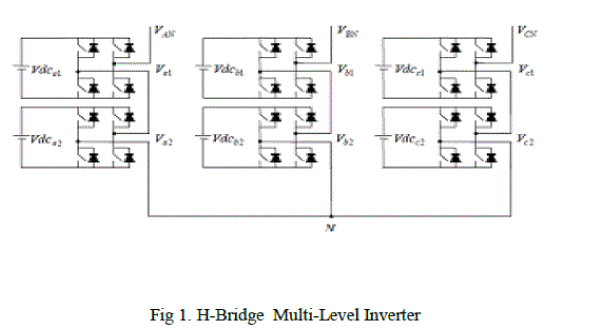 |
| VAN is voltage of phase A, which is the sum of Va1, Va2, and Va3. The same idea is applied to phase B and phase
C. To synthesize five-level phase voltage, three firing angles are required. The same three switching angles can be used in
all three phase with delaying 0, 120, and 240 electrical degree for phase A, B, and C, respectively. According to three-phase
theory, line voltage can be expressed in term of two phase voltages. For example, the potential between phase A and B is
so-called VAB, which can be written as follows: |
 |
| where, |
| VAB is line voltage VAN is voltage of phase A with respect to point N and VBN is voltage of phase B with respect to point N
theoretically, the maximum number of line voltage levels is 2m-1, where m is the number of phase voltage level. |
DISCRETE WAVELET TRANSFORMS |
| In the continuous wavelet transform (CWT), the mother wavelet is dilated and translated continuously over a real
continuous number system. Therefore, it can generate substantial redundant information. The mother wavelet can be dilated
and translated discretely by replacing a=ao
m and b=nboao
m, where ao and bo are the fixed constants with ao>1, bo>0, and m, n
belongs to N. Here N is the set of positive integers. Then the discretized mother wavelet function can be defined as |
 |
| And the corresponding Discrete Wavelet Transform (DWT) can be defined as |
 |
| DWT decomposes a signal into various scales with different time and frequency resolutions. In the DWT, the
procedure starts with passing the discrete signal x[n] of length N through a digital low pass filter with impulse response
g[n] and a digital high pass filter with impulse response h[n]. The output of these filters consists of N wavelet coefficients.
This constitutes first level of decomposition of the discrete signal and can be mathematically expressed as |
 |
 |
| The approximation coefficients (a1) at first level of resolution are used as inputs for another pair of wavelet filters (identical
with the first pair) after being down sampled by two. The filters at second level of resolution generate sets of
approximations and details coefficients of length N/2. This constitutes second level of decomposition of the discrete signal
and can be mathematically expressed as |
 |
 |
| Fig.2 shows the two-level decomposition of a discrete signal of the discrete wavelet transform. It uses the high pass filters
(H) and the low pass filters (G) in the decomposition process. If a wavelet function matches the shape of a signal well at a
specific scale and location, then a large transformation value will be generated. On the other hand, if the wavelet function
and signals do not correlate well, then a low value of transformation will be generated. |
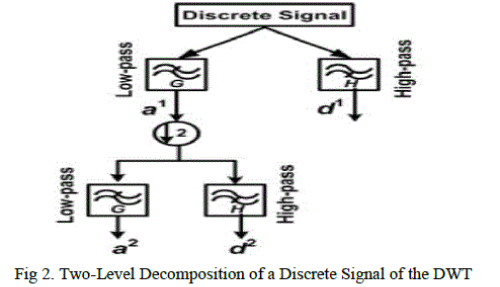 |
EXPERIMENTAL SETUP |
| Fig 3. shows the hardware circuit diagram of the three H-Bridge Multi-level inverter which each phase of the multilevel
inverter consists of two H-Bridges with four switches in each H-Bridge. The gate pulse for the switches is given using
Renesas processor which is as shown in the Fig 3. Fig4. shows the experimental setup of the proposed system. The gate drive
circuit used here is the IR2110 and opto-isolator is used for the protection of the processor from the high voltage side which
is the MOSFET switches. Since the switches are working in a high voltage and current the processor and the driving IC’s are
not able to withstand that much amount of higher voltages so we are connecting it through an opt-isolator. |
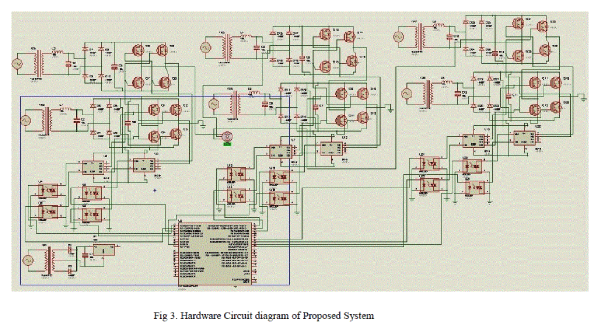 |
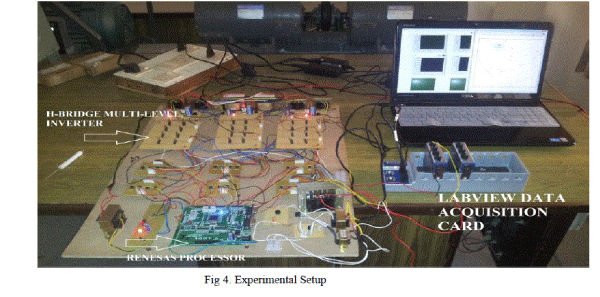 |
| The gate pulse for the H-Bridge multi-level inverter is generated based on sinusoidal pulse width modulation. The fault
in the circuit is created by opening one H-Bridge in any one of the phase in the inverter which is called as H-Bridge open
circuit fault. This voltage and current values are measured from the NI DAQ card and it is loaded in excel file. These values
are again copied in the matlab file and it is used for the feature extraction using discrete wavelet transforms. A MATLAB
program is used to extract the features of the faulted signals in which the signal is divided into 10 levels and the maximum,
mean and the standard deviation of the faulted signal is taken. Here the voltage and current signals from the hardware of the
H-Bridge multi-level inverter is acquired using the data acquisition card DAQ 9225 for the voltage signal and DAQ 9227
for current signal from the NI LABView data acquiaition. Fig 5 shows the LABView block diagram for the acquisition of
the voltage signal and Fig.6 shows the LABView data acquisition of the current signal. |
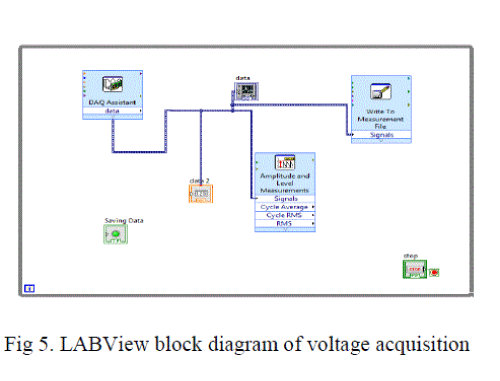 |
EXPERIMENTAL RESULT AND ANALYSIS |
| To diagnose the faults in the multi-level inverter system Fig.4 shows the experimental test has been conducted using 30V
prototype system. It has an H-Bridge multi-level inverter which is fed by rectifier in the input of the inverter. In which each
H-Bridge will have its own separate DC sources. Three phase H-Bridge multilevel inverter is been implemented here in the
hardware. The Renesas processor used for producing the gate pulses to the MOSFET switches. These values of the signals
are taken and the time period of the fault is extracted and the fault time is measured by using this feature of the signal and it
is analyzed. In following sections the output voltage of the multi-level inverter during the healthy condition and the fault
conditions has been discussed. |
| A. Output voltage of the multi-level inverter during healthy condition |
| Fig 7. Shows the output single phase to neutral voltage of the H-Bridge multi-level inverter during healthy condition
without any faults in the multi-level inverter. |
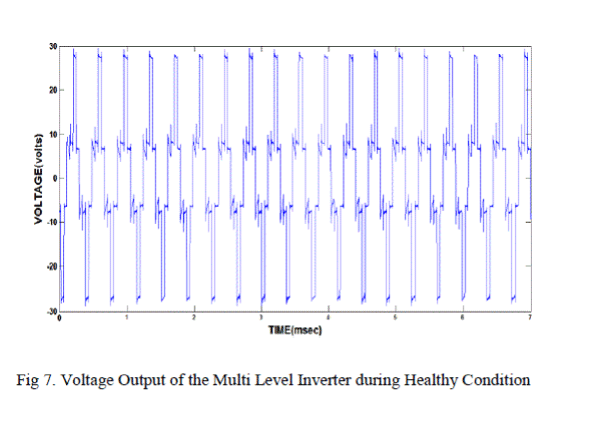 |
| B. Current output of the multi-level inverter during healthy condition |
| Fig 8. Shows the output current of the H-Bridge mu;ti-level inverter during healthy condition. the current was measured
through a shunt resistane. |
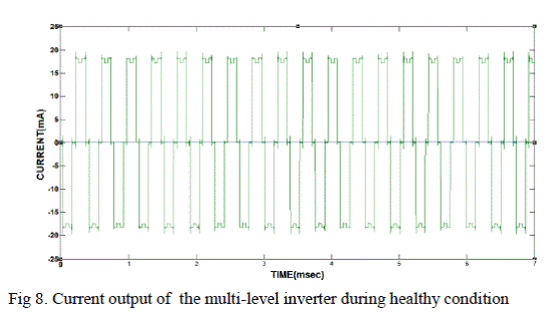 |
| C. Voltage output of the multi-level inverter during one H-Bridge open fault |
| The output voltage of one H-Bridge open failure fault is shown in the Fig 9. When there is a failure in the gate pulse of
the multi-level inverter the output voltage will have some distortions in their values which are as shown in the waveform
below. |
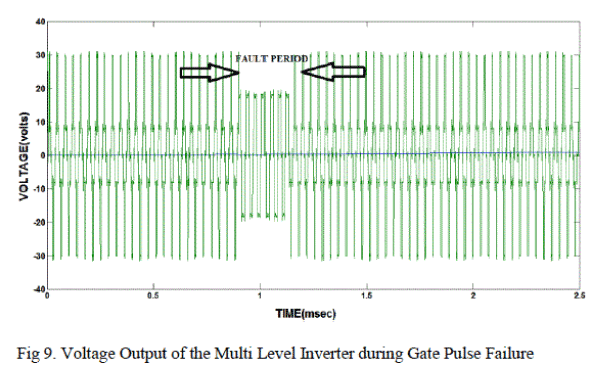 |
| The gate pulse failure is made by opening a manual switch across the H-Bridge of any phase. At steady state
operation of the inverter the switch is open and there occurs a distortion in the value of the current and voltage which is
denoted as fault period in the above Fig 5.The open circuit fault is created at 1msec and cleared at 1.2msec. during this
period the output voltage magnitude is reduced to 20vlts and a level in the output voltage is also reduced as shown in the
Fig 9. |
| D. Feature extraction system |
| The discrete wavelet transforms is used for the feature extraction system. The time and frequency feature of the output
current signal of the multi-level inverter during the fault condition is been extracted and the fault values of time and
frequency is been known from the extracted feature of the discrete wavelet transforms. The DAQ 9225 voltage acquisition
card will read the voltage level upto 300 rms and the current acquisition card DAQ9227 will read upto the level of 5Amps
directly from the hardware. The data sent to the computer is loaded in a excel sheet and again it is copied to the matlab file
which is used for the feature extraction system. A matlab program is used for the feature extraction system which gives the
standard deviation of the signal used for the analyzing the faulted signal. |
| 1. The extracted feature of the output current of the multi level inverter during healthy condition is shown in the Fig
10. The distortion ratio of this normal voltage is 148.58%. |
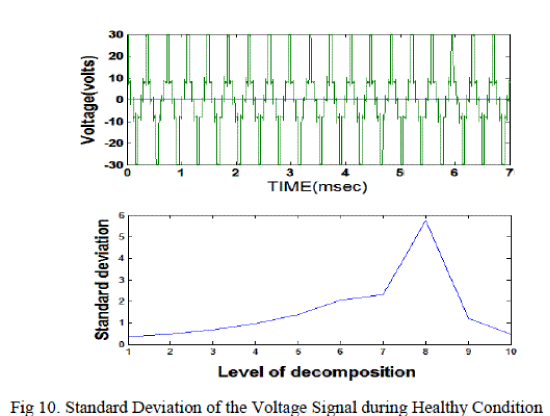 |
| 2. The extracted time and frequency feature using wavelet packet transforms during gate pulse failure is shown in the
Fig 8. The level of distortion ratio during the one H-Bridge open circuit fault is about 239.86%. The standard
deviation value at fundamental frequency is increased up to 10 as shown below in Fig 11. |
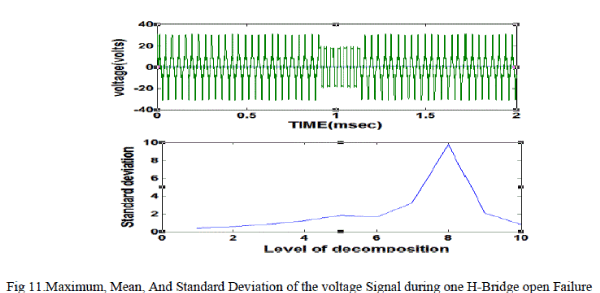 |
| The time and frequency features are extracted in the MATLAB using the mat file program in the command window
which is used find the fault values of the time and frequency of output current of multi-level inverter. This is used to
analyze the fault of the multi-level inverter. |
| The distortion ratio of the feature is calculated by, |
| %DR = std(D3) + std(D4)+std(D5) / std(D8) *100 (9) |
CONCLUSION |
| A H-Bridge multi-level inverter can be used for the medium power applications and high voltage system
interconnections. A fault diagnosis method is been implemented in the H-Bridge multi level inverter. The considered for
the proposed system is the H-Bridge opening fault. A manual connector pin is used to create the faults of the multi-level
inverter. For this fault there will be a change in the output voltage and current of the multi-level inverter. The output voltage
and current signals of the multi-level inverter is been extracted using the discrete wavelet transforms and the analysis is
made in the proposed work. The discrete wavelet transforms separates the signals in to approximations and details by the
use of high pass and low pass filters. The mean, maximum, and the standard deviation values of the voltage and current
signals have been taken and analyzed. In future work these values will be given to the neural network and it is trained for the kind of faults and the corresponding gate pulse is changed to balance the output voltage of the multi-level inverter. Thus
the faults in the multi-level inverter is been analyzed using the wavelet packet transforms. |
References |
- Surin Khomfoi and Leon M. Tolbert , chapter 31 multilevel power converters, The university of tennssae, 2010.
- Farid Khoucha, Soumia Mouna Lagoun, Khoudir Marouani, Abdelaziz Kheloui, Hybrid Cascaded H-Bridge Multilevel-Inverter Induction- Motor-Drive Direct Torque Control for Automotive Applications, IEEE Transactions on Industrial Electronics, vol. 57, no. 3 PP.892-899, 2010
- Neelam Mehala, Current Signature Analysis for Condition Monitoring of Motors, International Journal of Electronics and Computer Science Engineering. Vol 1, No.3, PP.1629-1633, 2011.
- Khalaf Salloum Gaeid and Hew Wooi Ping , Wavelet Fault Diagnosis and Tolerant of Induction Motor, International Journal of the Physical Sciences Vol. 6(3), PP. 358-376, 2011.
- Surin Khomfoi and Leon M. Tolbert, Fault Diagnostic System for a Multilevel Inverter Using a Neural Network, IEEE Transactions on Power Electronics, vol. 22, no.3 PP.1062-1069, 2007.
- Abdesh Shafiel Kafiey Khan M ,Wavelet Based Diagnosis and Protection of Electric Motors, IEEE Transactions on Industrial Electronics, vol. 57, no.3 PP.266-272, 2010.
- Saleh S.A and Azizur Rahman M, Analysis and Real-Time Testing of a controlled Single-Phase Wavelet-Modulated Inverter for Capacitor-Run Induction Motors, IEEE Transactions on Energy Conversion, vol. 24, no. 1 PP.21-29, 2009
- C.Muniraj and S.Chandrasekar, Adaptive Neuro-Fuzzy Inference System for Monitoring the Surface Condition of Polymeric Insulators Using Harmonic Content, Generation, Transmission & Distribution, IET, vol. 5, no. 7 PP.751-759, 2011.
- L. M. Tolbert, F. Z. Peng, and T. G. Habetler, Multilevel converters for large electric drives, IEEE Transactions on Industry Applications, vol. 35, no. 1, pp. 36âÃâ¬Ãâ44, 1999.
- P. N. Enjeti, P. D. Ziogas, and J. F. Lindsay, Programmed PWM techniques to eliminate harmonics: A critical evaluation,IEEE Transactions Industry Applications, vol. 26, no. 2, pp. 302âÃâ¬Ãâ316, 1990
|